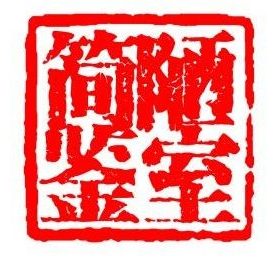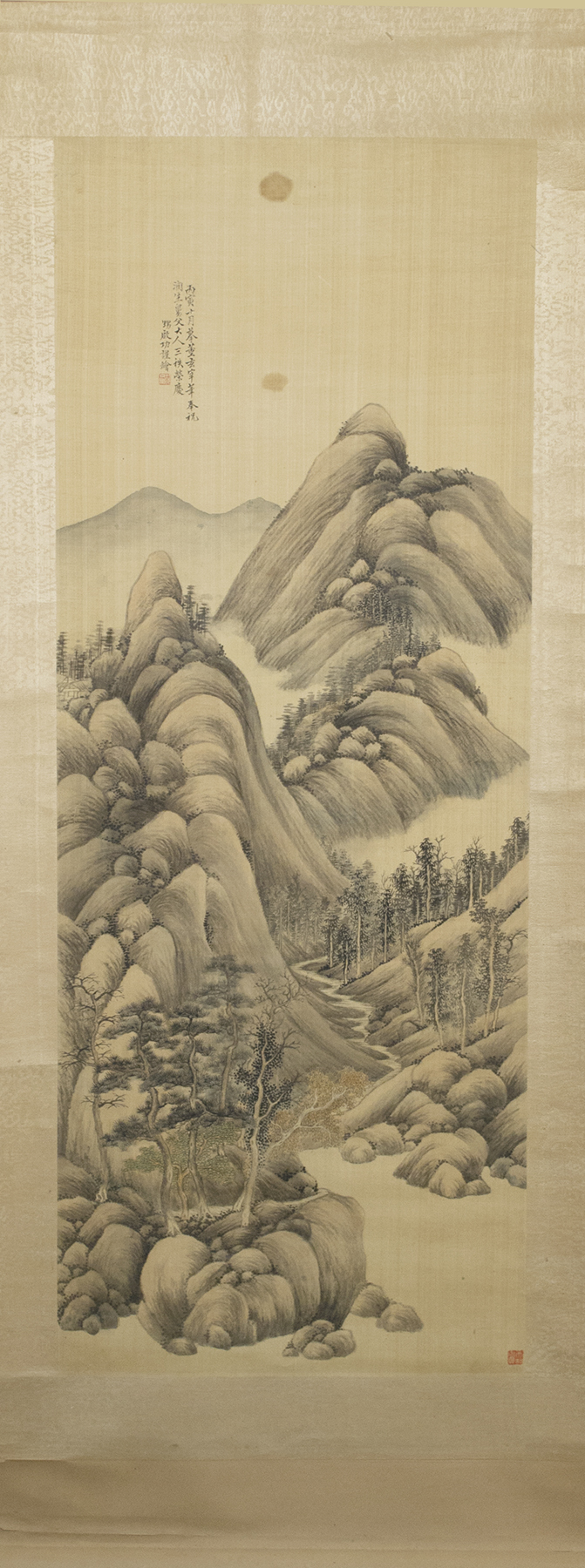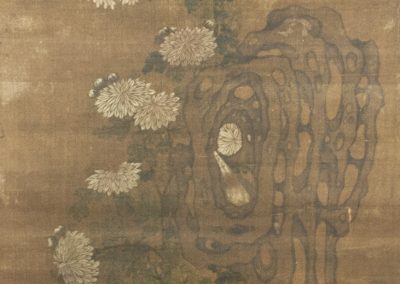Paintings
Ink on silk paintings are a quintessential aspect of Chinese art. Just in this exhibit, we can view a painting from the Ming dynasty in 1589 which uses ink on silk as well as a painting from the Qing dynasty in 1926 which also uses ink on silk almost four centuries later.
Typically painted on scrolls, Chinese paintings were usually rolled up and stored away when not in use. Paintings were designed to be appreciated for a brief time and then put away until the next viewing. This practice helped to preserve many of these pieces, some of which are hundreds of years old. Compared to western style oil paintings, ink on silk paintings are far more susceptible to aging. As you may notice as you walk through the exhibit, some of the scrolls are darker than others. Ink on silk paintings will often darken with age. This is why the older painting from the Ming Dynasty appears much darker than the other more recent paintings.
The Flowers and Taihu Rock painting attributed to Zhou Zhimian is the oldest piece in this exhibit. Painted during the Ming Dynasty, a time period of great affluence and a large scholarly class, this bird and flower painting was likely hung in a scholar’s studio as a sign of good fortune and to promote calmness of mind. In traditional Chinese culture, both the bird and the chrysanthemums seen in this painting connote good fortune and a life of ease in retirement. This rock formation in particular came from Lake Tai, famous for it’s unique, porous stones, many of which were seen in the gardens of the elite. The figuration on the blue silk is typical of a Japanese mounting. This suggests that this painting was at some point bought by a Japanese collector and remounted in Japan.
If you would like to listen rather than read, please click below.
Another painting from the Ming Dynasty is a landscape in the blue green style attributed to Shao Mi. It is also a hanging scroll painted with ink and color on silk. In this painting, Shao Mi depicts a man’s journey from the base of a mountain, across a lake, and up the mountain. This landscape adheres to the concepts of traditional scholar paintings in which the viewer visualizes himself as the figure near the bottom of the painting traveling up the mountain. Common among the social elite, who were often confined in urban cities, these paintings served as a respite from reality by allowing the viewer to go on a mental and spiritual journey in an idyllic natural environment.
The next piece is from the Republic Period in China, around 1926. This landscape in the style of Dong Qichang is painted by Qi Gong using ink and color on silk. Qi Gong was a renowned Chinese calligrapher, painter, art connoisseur, and Sinologist. In his inscription on the scroll, Qi Gong states that he is imitating Dong Qichang, an influential Chinese painter, calligrapher, art theorist, and art connoisseur from late Ming period. Dong Qichang’s art theory emphasized that artists need to creatively transform the style of the past masters. His theory was widely followed by Qing dynasty artists. In the twentieth century, Dong Qichang became a past master himself, and Qi Gong creatively imitated his style in this painting, and thereby partook in his tradition of evoking the past.



